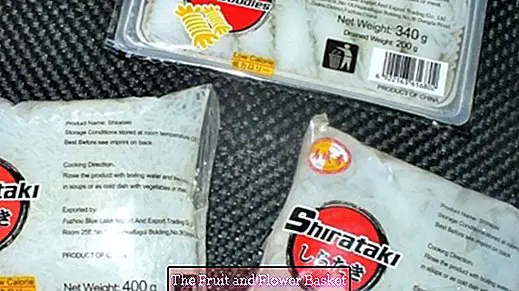The konjac root (devil tongue)
The konjac root: Almost calorie-free, healthy and a good weight loss aid
Those who pay attention to their weight, pay attention, have to pay attention, suffer from intolerances or simply want to eat healthy should get to know the products from the Asian konjac root.
Below I have summarized some information about this root (devil's tongue):
Where does the konjac root come from and what does it consist of?
- The konjac root is widespread in Asia. It grows in Japan, West and Central China and can reach a diameter of 25 cm.
- It consists of 60% glucomannan, 25% starch, 2-5% cellulose and 5-10% fat, 3-5% sugar and minerals.
- The konjac root contains 40% fiber. If one compares this result to a wholemeal bread, this comes only to 12% of fiber, which, however, belong to the insoluble.
- The konjac root contains soluble fiber (glucomannans), which has the advantage of binding up to 50 times more fluid than its own volume.
- Calorie-free is a key reason why Kojak noodles, for example, are ideal for dieting and are great for dinner on a low-carbohydrate (low-carbohydrate diet) diet.
- Konjac glucomannans (starch-like substances derived from branched carbohydrate chains) absorb toxins that are excreted in the stool and do not re-enter the bloodstream. But not only toxins are transported out, but also a large portion of dietary fats, so simply less fat remains in the body.
- Glucomannans have a major impact on cholesterol levels and lower "bad cholesterol" by 16% and contribute to the improvement of blood pressure and blood lipid levels.
- Konjac root preparations are recommended for diabetics, as the increase in blood sugar after meals is greatly alleviated. The glycemic load (GL) is zero. The GL indicates how 100 grams of a food affects blood sugar levels. The Glycemic Index (GI, Glys) indicates how much a food raises blood sugar levels as soon as you consume 50 grams of carbohydrate through this food Root and its derived preparations contain absolutely no usable carbohydrates can be consumed by it, as much as one likes. You never reach the 50 gram amount!
Products from the konjac root
Konjac noodles (also called shirataken noodles)
- Konjac noodles are not extracted from grains, but from a root. Similar to their appearance glass noodles, are white, pre-cooked, relatively tasteless and are sold in water in packets of 300-400 grams sold (Asian shop or Internet). The price is depending on the variety from 1.40 euros. They are available as spaghetti, tagliatelle, pasta noodle or in rice kernel form.
- For the pasta, the root is ground to flour. This is enriched with water and calcium hydroxide, mixed until a viscous mass is formed. This is cooked and shaped for the different types of pasta.
- The noodles are almost zero in calories (about 9 calories per 100 grams - in contrast, ramen or glass noodles have 360 calories / 100g), gluten free, fat free and basic. Therefore, they fit in with a healthy nutritional concept, detoxification treatment and any deacidification program.
- Another important benefit of these noodles is that they sustainably fill you for several hours without delivering any calories.
- Also, they are ready to eat in a minute and can be prepared in a few seconds. Ideal also for the fast kitchen! They can be roasted or processed in lettuce, have little taste of their own, just like glass noodles, and therefore go well with wok dishes, soups and curries.
How are they prepared?
- Take the pasta from the pack
- Rinse well under running water
- Brew with boiling water for 1 minute
- Put noodles under the wok / pan vegetables, under dressing or in a sauce? mix and let stand for a few minutes.
konjac flour
The flour can be used to thicken all food. If you stir it with water, a jelly-like, almost taste-neutral mass is formed, which also calms cold bowls and desserts without calories.
In all cases where conjunctivae are eaten, be sure to drink enough.
Konjac in the body care
The konjac root has been used by the Japanese since time immemorial in the beauty treatment: As a sponge!
Initially intended only for baby and child care, it has become more and more beneficial to the entire family over time and is suitable for dry and sensitive skin. People with hypersensitive skin benefit from the gentle tissue of the sponge.
The root is naturally a moisturizing alkaline fiber that balances the acidity of the skin. Konjac contains water, sodium, potassium, magnesium, proteins, carbohydrates, lipids, folic acid, zinc, panthotenate, iron and vitamins A, B1, B2, B6, B12 and D.





